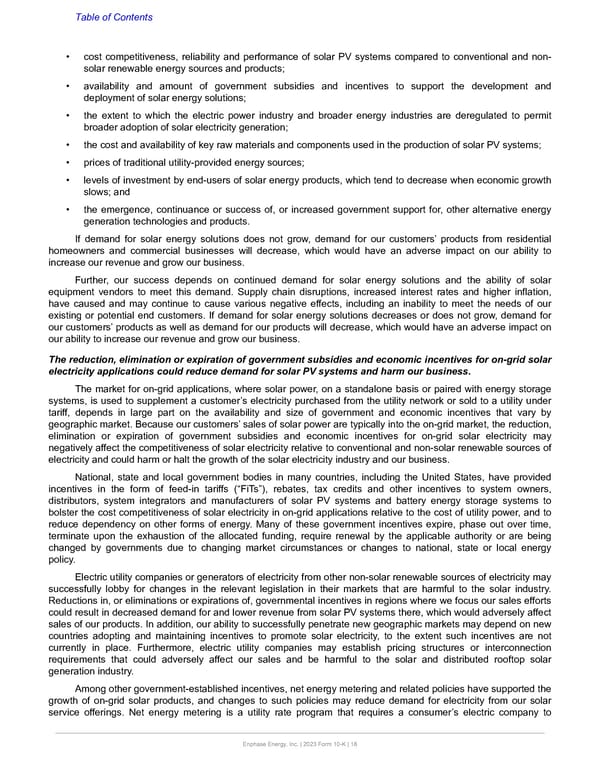Table of Contents • cost competitiveness, reliability and performance of solar PV systems compared to conventional and non- solar renewable energy sources and products; • availability and amount of government subsidies and incentives to support the development and deployment of solar energy solutions; • the extent to which the electric power industry and broader energy industries are deregulated to permit broader adoption of solar electricity generation; • the cost and availability of key raw materials and components used in the production of solar PV systems; • prices of traditional utility-provided energy sources; • levels of investment by end-users of solar energy products, which tend to decrease when economic growth slows; and • the emergence, continuance or success of, or increased government support for, other alternative energy generation technologies and products. If demand for solar energy solutions does not grow, demand for our customers’ products from residential homeowners and commercial businesses will decrease, which would have an adverse impact on our ability to increase our revenue and grow our business. Further, our success depends on continued demand for solar energy solutions and the ability of solar equipment vendors to meet this demand. Supply chain disruptions, increased interest rates and higher inflation, have caused and may continue to cause various negative effects, including an inability to meet the needs of our existing or potential end customers. If demand for solar energy solutions decreases or does not grow, demand for our customers’ products as well as demand for our products will decrease, which would have an adverse impact on our ability to increase our revenue and grow our business. The reduction, elimination or expiration of government subsidies and economic incentives for on-grid solar electricity applications could reduce demand for solar PV systems and harm our business. The market for on-grid applications, where solar power, on a standalone basis or paired with energy storage systems, is used to supplement a customer’s electricity purchased from the utility network or sold to a utility under tariff, depends in large part on the availability and size of government and economic incentives that vary by geographic market. Because our customers’ sales of solar power are typically into the on-grid market, the reduction, elimination or expiration of government subsidies and economic incentives for on-grid solar electricity may negatively affect the competitiveness of solar electricity relative to conventional and non-solar renewable sources of electricity and could harm or halt the growth of the solar electricity industry and our business. National, state and local government bodies in many countries, including the United States, have provided incentives in the form of feed-in tariffs (“FiTs”), rebates, tax credits and other incentives to system owners, distributors, system integrators and manufacturers of solar PV systems and battery energy storage systems to bolster the cost competitiveness of solar electricity in on-grid applications relative to the cost of utility power, and to reduce dependency on other forms of energy. Many of these government incentives expire, phase out over time, terminate upon the exhaustion of the allocated funding, require renewal by the applicable authority or are being changed by governments due to changing market circumstances or changes to national, state or local energy policy. Electric utility companies or generators of electricity from other non-solar renewable sources of electricity may successfully lobby for changes in the relevant legislation in their markets that are harmful to the solar industry. Reductions in, or eliminations or expirations of, governmental incentives in regions where we focus our sales efforts could result in decreased demand for and lower revenue from solar PV systems there, which would adversely affect sales of our products. In addition, our ability to successfully penetrate new geographic markets may depend on new countries adopting and maintaining incentives to promote solar electricity, to the extent such incentives are not currently in place. Furthermore, electric utility companies may establish pricing structures or interconnection requirements that could adversely affect our sales and be harmful to the solar and distributed rooftop solar generation industry. Among other government-established incentives, net energy metering and related policies have supported the growth of on-grid solar products, and changes to such policies may reduce demand for electricity from our solar service offerings. Net energy metering is a utility rate program that requires a consumer’s electric company to Enphase Energy, Inc. | 2023 Form 10-K | 18
 Annual Report Page 17 Page 19
Annual Report Page 17 Page 19